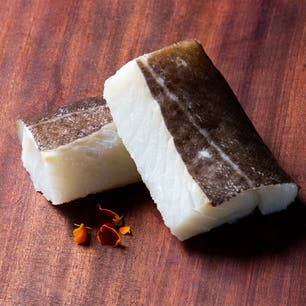Codfish, from peasant dish to gourmet dish
From the kitchen of our grandmothers to the table of starred restaurants around the world. Let's retrace together the delicious rise of cod from "poor" food to the prized and sought-after gourmand exclusivity of more refined gourmets.
The codfish is a delicious ingredient that has captured the interest of humans for centuries. It is a popular fish that is loved by seafood enthusiasts all over the world. With its mild, delicate flavor and firm texture, cod is a versatile ingredient that can be used in a wide variety of dishes. Order codfish online on our website and receive it in the comfort of your home in Hong Kong.
Cod or stockfish?
Let's start by clearing the field of possible misunderstandings: cod and stockfish are not the same thing. Or rather, they are two different ways of preserving the same fish, the northern cod.
By the term cod we refer to cod preserved by salting and then subjected to a longer or shorter period of curing.
When we talk about stockfish, on the other hand, we are dealing with cod that has been dried without the use of salt.
In both cases, however, in order to consume it, it must still be immersed in cold water for a long time so that the fibers have a chance to return to their original consistency.
Cod recipes
Having clarified this basic point, all that remains is to find out how to cook cod.
Region you go, cod recipe you find. We could summarize in this way the wide spread of this dish among the traditional cuisines of Italy.
Starting from the north, how can we fail to mention the famous Vicenza-style cod. Its recipe - for which every family in the city of Vicenza boasts a secret variant - calls for it to be dipped with plenty of onions in equal parts oil and milk and cooked very slowly for hours inside a strictly earthenware pan. Also in the north we find baccalà mantecato, a delicacy spread over fried polenta croutons.
Then in Liguria, especially in western Liguria, there is brandacujùn, a dish made with potatoes and stockfish (or codfish).
Moving down, in Tuscany, strict mention must be made of baccalà alla livornese: large slices previously soaked, floured and fried in olive oil, then tossed in a ready-made sauce of tomatoes, onions and garlic that must then be cooked again with diced potatoes.
In Campania, it is not Christmas if the dinner salad on the 24th is not "reinforced" with capitone and fried codfish.
In Basilicata, baccalà alla lucana, prepared as tradition dictates with cruschi peppers, is all the rage. In Sicily, there is a Sicilian-style version that includes the addition of pine nuts, raisins, tomatoes, potatoes and black olives.
Let yourself be tempted by all these recipes, our advice is only to prefer the oil-cooking technique - or confit cooking - for their realization. In fact, these are dishes that take a long time to prepare: keeping the temperature of the oil low allows you to create a sort of protective barrier around the fish that prevents the escape of liquids and thus preserves flavor and texture.
Where to Buy Codfish
Cod can be found just about everywhere: from the shelves of large retail supermarkets to the stalls of local markets. But if the choice once again has to be made in favor of "rare and precious" quality and flavor, then a premise is necessary. Indeed, a must. If we want to elevate this typical food of poor Italian cuisine to a gourmet dish loved by the greatest chefs halfway around the world, it is necessary to make a qualitative leap and choose to buy a stellar cod, such as Giraldo's Lomo Especial.
A fillet from a Gadus Morhua - that's the scientific name for the Nordic cod - hooked in the icy waters of the Faroe Islands and processed directly on board. A cod that is cured in salt at a controlled temperature for long months and then carefully and skillfully cut into uniform parts so as to ensure homogeneous desalting and, above all, uniformity of taste. Simple steps, however, that underlie an ancient know-how and a truly exceptional attention to quality and taste. In fact, desalting is done only at the request of the customer - who thus can count on a product freshly prepared - and exclusively with still, ice-cold water, because running water, which would certainly speed up the whole process, could damage the texture and integrity of the pulp.







